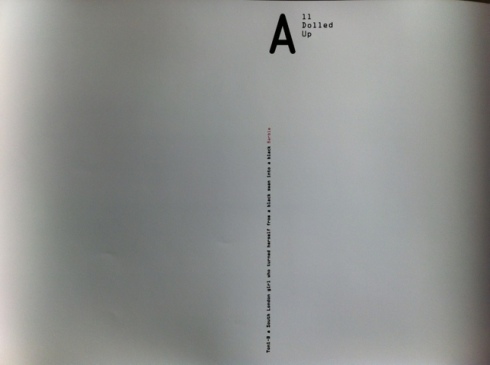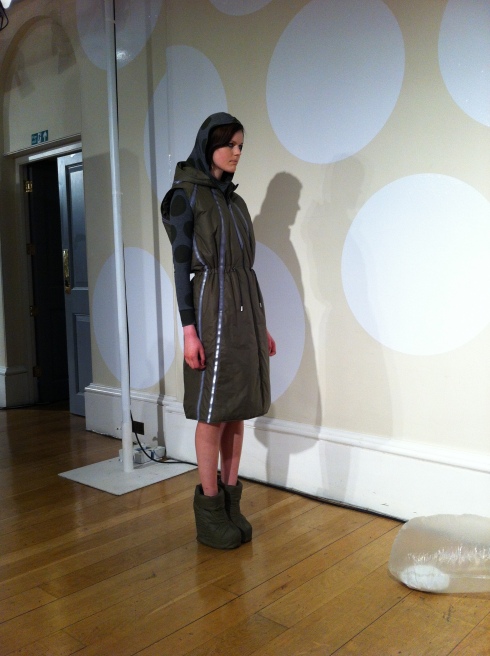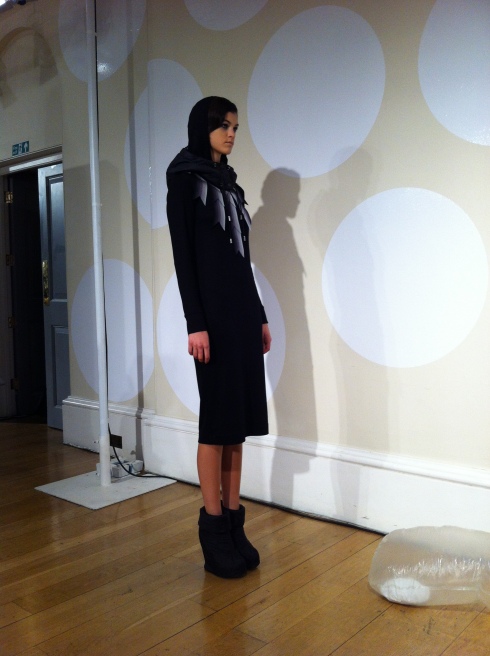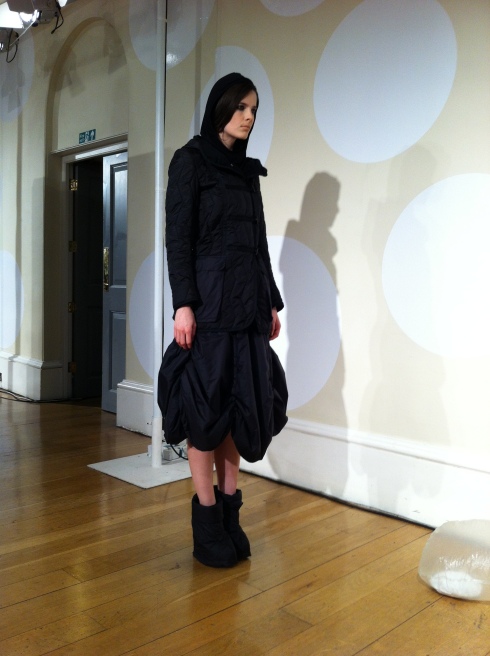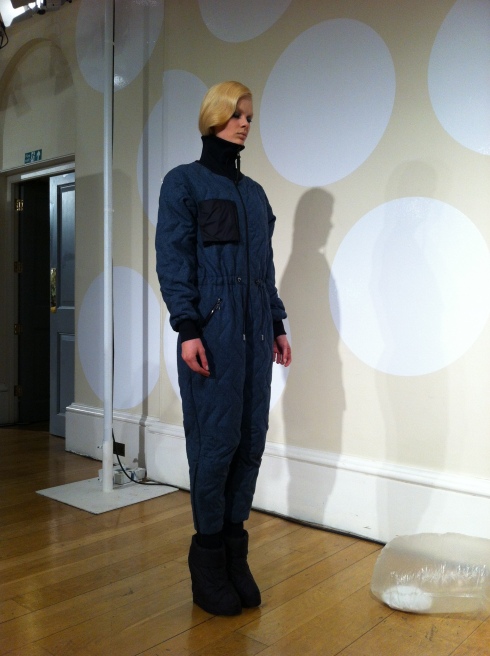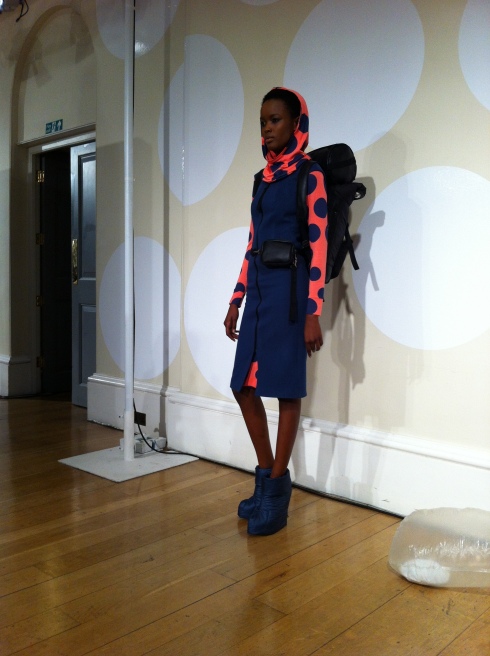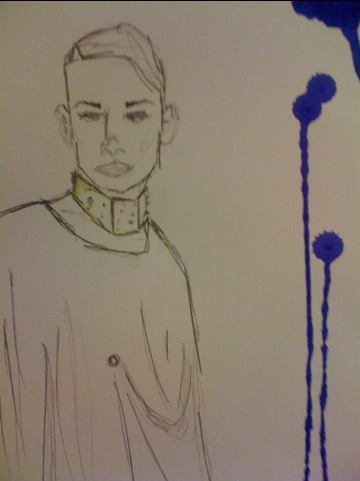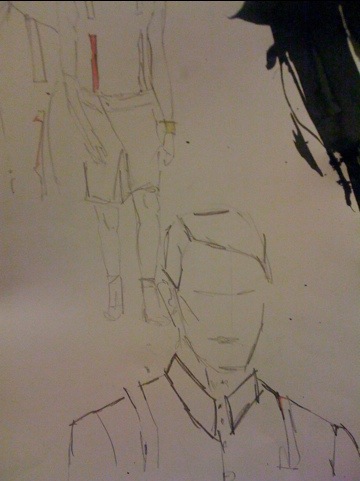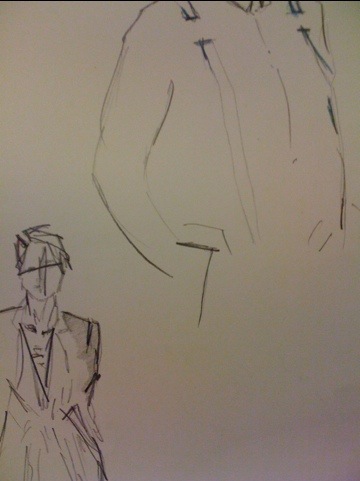Matteo Molinari
6 Jan

On the 2nd of February 2011 LCF went about the unveiling of its MA graduate collections at the V&A. Industry cheeses like Harold Tillman, chairman of the British Fashion Council, watched as 22 agitated graduates debuted their collections. The annual showcase is renowned for spotlighting future fashion peacocks, and has launched the careers of designers such as Manjit Deu, whose label is now stocked in Harrods.
The big momma award of the night, Collection of the Year, was awarded to 27-year-old menswear designer Matteo Molinari. Hailing from Auronzo di Cadore, a small village on the Italian Alps, Molinari’s winning collection pays huge tribute to his Italian heritage, focusing on sharp tailoring with modern touches like crochet and woven cobwebs, decking the backs of matador tuxedos, blouson knits, jumpers and oversized hooded jackets in a subtle palette of black and white; Simple with a twist of elegance. “The complex crochet techniques I worked with are something that all the generations of women in my family used and then taught their daughters the same traditional methods. Also the typology of tailoring I did is Italian, during the manufacturing of my garments I realised the differences between the English way and the Italian way of tailoring”.
The sophistication of Matteo’s collection is one rarely seen from such a young designer. Usually, the lively, little sproglets spend the early days of their career experimenting with exuberant shapes, ambitious styles and startling bids. “Keeping that in mind, I tried to be different – starting from the traditional male wardrobe and working on the men’s essentials: the suits, the trench-coat, the coat and the white shirt. I changed proportions and I elaborated a persona silhouette: sharp for tailoring and structured and architectural for the coats adding the cross-gender twist of using handmade lace in a graphic and masculine way”.
 “Everything starts subconsciously with some sketches and writings about some random ideas on the paper. After this phase I’ll deepen my research on a group of ideas reading and studying a lot about the topic I’m into. When I finish it, I start to gradually eliminate elements and redundant ideas trying to become more technical about one or two techniques (crochet for example). In the same time, from my research, I decide for one or two general silhouettes to work with. Then I sketch hundreds of sketches developing garments according to the techniques and silhouettes. The most important thing is the filtering of all the process through my own aesthetic, life experiences, iconography and taste: I don’t really know where I’m going, but for sure I know what I don’t like and I don’t want in my collection”.
“Everything starts subconsciously with some sketches and writings about some random ideas on the paper. After this phase I’ll deepen my research on a group of ideas reading and studying a lot about the topic I’m into. When I finish it, I start to gradually eliminate elements and redundant ideas trying to become more technical about one or two techniques (crochet for example). In the same time, from my research, I decide for one or two general silhouettes to work with. Then I sketch hundreds of sketches developing garments according to the techniques and silhouettes. The most important thing is the filtering of all the process through my own aesthetic, life experiences, iconography and taste: I don’t really know where I’m going, but for sure I know what I don’t like and I don’t want in my collection”.
There’s nothing I find more appealing than a modest master of his game, (well except a litre of chocolate fudge brownie ice cream, drenched in toffee syrup) so I was pleasantly wooed when I asked Matteo where he saw himself in the future and he non-hesitantly responded “Still struggling trying to do what I like to do, but hopefully more serene and satisfied”. With all the industry buzz circulating around him at the moment, like a swarm of sour faced, sartorial mosquitoes frantically dazed by fresh blood, it’s apparent his future could potentially be set. However, if it all goes pair shaped and the unlikely demise of his designing career comes to pass, Matteo has vowed to finish “Trying to finally understand Hegel’s The Phenomenology of Spirit, and in the meantime work at KFC”.
Often found drinking and dancing in some of the worst European clubs, Matteo likes to stay in the middle of the crowd looking around. “I admire self-confidence, people dancing on the edge of the abyss”. Extraverts like his friend Linda “We don’t see each other often. She’s living in Italy, between Verona and Venice, She’s pale and austere; she can talk to you about David Tibet and Genesis P. Orridge for 4 hours non-stop, as easily as not say a word to you for days.
Every time I see her I think she has something unique in her voice, in her long dark hair, in the way she looks at you. She can wear a vintage Lanvin in the morning and a samba costume during the afternoon of the same day. Every word she says to me opens new worlds, even if she’s just speaking about Mariano Fortuny or the last kebab she had coming back drunk from a gig. I would like to dress her but unfortunately I’m not sure she likes my collection”. Ahem, well I’m free for fittings!
We are all eagerly anticipating Matteo’s forth coming collections, and I wonder if we are witnessing the young, gripping roots of the next big name in knitwear and more importantly menswear.
Insanity
6 Jan“All poets are mad,” asserted English writer Robert Burton in The Anatomy of Melancholy (1621). Although Burton’s exaggeration may initially appear ambivalent, there is a degree of truth in that allegation. Copious amounts of influential and innovative writers, artists and musicians have reportedly been diagnosed or suspected of having a psychological disorder. Creativity seems common amongst individuals afflicted with either a mood disorder or in some cases a psychotic disorder such as schizophrenia. However, the idea that association implies causation is unfairly deterministic. It is unrealistic to assume that an individual afflicted with a mental disorder will possess creative ability. Equally, a highly creative individual does not necessarily have a psychological illness. Even so, certain mood disorders and psychotic disorders such as schizophrenia seem to affect an individual’s perception on the world and ability to use seemingly irrelevant information. The recognition of the connection between madness and creativity allows one to accept that perhaps mental illness essentially facilitates creativity.
The most common mental illness amongst creative thinkers is thought to be manic-depression, also known as bi-polar disorder. Bi-polar disorder has similar symptoms as major depression in that those afflicted experience periods of desolation and melancholy. However, bi-polar disorder additionally includes bouts of “mania” which may manifest as feelings of euphoria or anxiety. Connie M. Strong of Stanford University suggests that “people with bi-polar disorder might also have creative tendencies because they see the world in two ways, with the same surroundings appearing differently to them depending on whether they are feeling manic or depressed.” Someone with bi-polar who views the world in contrasting ways may be more open to new experiences as well as the imagination and the unconventional. Also, emotion serves as a sufficient means of motivation. (Bickhard, M. H. (1996). Troubles with Computationalism.)
In Patrick Gale’s novel Notes on an Exhibition, a psychological astute tale about a troubled artist named Rachel Kelly who suffers from severe bi-polar disorder. Gale writes that when Rachel is free of medication for her disorder and soaring towards a high, she produces some of her greatest work and so she often refuses to take it altogether.
Research provides support for the idea that creative people are more likely to have traits associated with mental illness. One study found that mood disorders, suicide and institutionalisation tended to be 20 times higher among major British and Irish poets from 1780 to 1800. Another study, based on 291 successful and creative men in different fields, found that 69 per cent had a mental disorder of some kind. Scientists were the least affected, while artists from all fields and writers had increased diagnoses of psychosis.
“Most theorists agree that it is not the full-blown illness itself, but the milder forms of psychosis that are at the root of the association between creativity and madness,” says Emilie Glazer, experimental psychologist and author of one of the Oxford journal papers. “The underlying traits linked with mild psychopathology enhance creative ability. In severe form, they are debilitating.”
Research is also showing that traits associated with different mental illnesses have different effects on creativity. The creativity needed to develop theory is, for example, very different from that required for producing surreal fashion or art. Studies are now homing in on whether the psychosis that is linked to different types of creativity comes through schizophrenia, manic-depressive or cyclothymic traits, or traits associated with autism and Asperger’s disorders. A study at the University of Newcastle found significant differences between artistically creative people and mathematicians. Whilst a mokority of artists showed schizotypy traits, mathematicians did not, adhering to the idea that mathematics and engineering, two skills which require a huge amount of attention to detail, are closer to autistic traits.
Mental illnesses have been around for millenniums. Evolutionary theory suggests that in order for them to still be present, there must be some kind of survival advantage to them. It is argued that if they were completely bad, nature would have fought them off a long time ago. In some cases the advantage is clear. For example Anxiety can be a severe mental illness with devastating and consequent symptoms, yet it is also a trait that at a low level has survival advantages. In healthy proportions, it keeps us alert and almost animalistic when threats are sensed. “It can be difficult for people to reconcile mental illness with the idea that traits may not be disabling. While people accept that there are health benefits to anxiety, they are more wary of schizophrenia and manic depression,” argues Professor Gordon Claridge, emeritus professor of abnormal psychology at Oxford University, Claridge has edited a special edition of the journal Personality and Individual Differences, looking at the links between mental illness and creativity. “There is now a feeling that these traits have survived because they have some adaptive value. To be mildly manic depressive or mildly schizophrenic brings a flexibility of thought, an openness, and risk-taking behavior, which does have some adaptive value in creativity. The price paid for having those traits is that some will have mental illness.”
The stereotypical images of mad scientists working alone and preferring foaming beakers to friends, abound in literature, and reflect a popular perception of the aloof, detached and obsessive genius. But the idea goes back even further. 2000 years ago in Rome, the philosopher Seneca was obviously already on the case when he wrote: “There is no great genius without a tincture of madness.” However, creativity and ingenious is a concept which can neither be accurately measured, neither do we have any means of defining it. As a result, it is difficult to conclude whether or not mental illness and creativity are linked due to the lack of clarity. A traditional definition of ‘create’ implies the production of something new and original.
Studies also show that comedians are highly susceptible to depression. One theory is that humour is developed in an attempt to deal with depression, and that it works as a coping mechanism. One study reported by Rod Martin, author of ‘The Psychology of Humor’ looked at 55 male and 14 female comedians, all of which were famous and successful. It found that comedians tended to be superior in intelligence, angry, suspicious, and generally suffer from depression. It found that a majority of comedians dealt with suffering, isolation, and feelings of deprivation at an early age and that they used humour as a defense against anxiety, converting their feel ings of suppressed rage from physical to verbal aggression. “The comedic skills required for a successful career may well be developed as a means of compensating for earlier psychological losses and difficulties,”
The Devil has the best lines: How the devil has informed much of our great art, is recent spread in The Independent written by Phil Boucher it analysis the book The Devil As Muse written by Dr Fred Parker, fellow of Clare College, Cambridge, the book argues that fictitious concepts of the Devil have opened up a infinite dark world for artists to explore – and that these subtle undercurrents have created a modern view of Satan that focuses on individuals who are expelled, alienated and unbalanced. “He is the opposite,” “He is the thing you can’t have anything to do with.” explains Parker and maybe this is the reason why the dark side is so attractive to creative’s – after all, humans are naturally compelled to explore the unknown and the forbidden.
Through my research I have found that any conclusion between mental health and creativity, however factual, can still be classed as redundant, and that this may possibly always be the case due to the fact that there are no official or correct ways to calculate and validate creativity.
